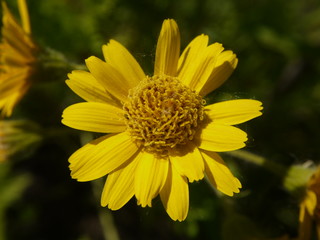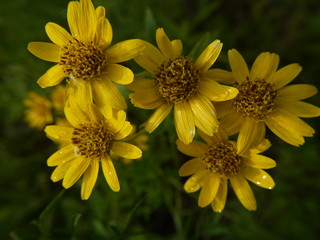home |
avr microcontroller & DIY electronics |
toolbox |
science club |
tuxtalk |
photos |
e-cards |
Online-Shop

no preservatives added blog |
computer and graphics corner |
herbal treasure chest |
splash into math |
stardust |
periodic table
american arnica - (arnica chamissonis)

how to grow:
I bought plants. It is said to be possible to grow them from seeds but they need to be either stratified or put into the soil in fall to be outside during the whole winter to germinate.
American arnicas are perennial and are hardy in US zones 5-8. They like to grow in full sun but are not drought resistant. Usually they start blooming in June.
medicinal properties:
While most studies are done with European arnica (arnica montanta) it is supposed that American arnica (arnica chamissonis) and heartleafed arnica (arnica cordifolia) have the same medicinal effects.
Arnica is known to be a natural pain reliever.
The plant is able to stimulate blood flow and can therefore help reduce swellings and pain. I can personally attest to this. A couple years ago when my ankle was sprained and swollen arnica together with yarrow was a great help. It greatly reduced the swelling and relieved my pain.
Arnica is usually better suited to heal tissue that is not broken but it is successfully used on bed sores and poorly healing wounds.
It can also be used to help remedy arthritis pain and to treat frostbite.
Arnica contains helanin which is responsible for its anti-inflammatory effects.
I haven't tried to make arnica salve myself but this website has a recipe:
https://learningherbs.com/remedies-recipes/arnica-ointment/

cautions and possible side effects:
- Arnica can be toxic when taken internally. It contains helanin which can cause e.g. severe liver damage or cardiac arrest. So it is better to only use it externally on wounds.
- You should not apply arnica when you are pregnant or breastfeeding.
- Some people might show an allergic reaction to arnica, especially people who are allergic to plants like ragweed, chrysanthemums, marigolds or daisies.
further reading:
Copyright © 2004-2025 Katja Socher, tuxgraphics.org



